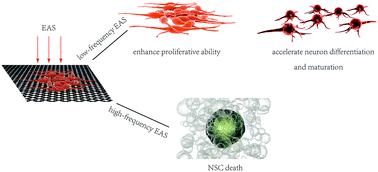当前位置:
X-MOL 学术
›
J. Mater. Chem. B
›
论文详情
Our official English website, www.x-mol.net, welcomes your feedback! (Note: you will need to create a separate account there.)
Cochlear implant-based electric-acoustic stimulation modulates neural stem cell-derived neural regeneration
Journal of Materials Chemistry B ( IF 7 ) Pub Date : 2021-09-01 , DOI: 10.1039/d1tb01029h Rongrong Guo 1, 2, 3 , Menghui Liao 3, 4 , Xiaofeng Ma 5, 6, 7 , Yangnan Hu 3, 4 , Xiaoyun Qian 6, 7 , Miao Xiao 1 , Xia Gao 6, 7 , Renjie Chai 3, 4 , Mingliang Tang 1, 3, 4
Journal of Materials Chemistry B ( IF 7 ) Pub Date : 2021-09-01 , DOI: 10.1039/d1tb01029h Rongrong Guo 1, 2, 3 , Menghui Liao 3, 4 , Xiaofeng Ma 5, 6, 7 , Yangnan Hu 3, 4 , Xiaoyun Qian 6, 7 , Miao Xiao 1 , Xia Gao 6, 7 , Renjie Chai 3, 4 , Mingliang Tang 1, 3, 4
Affiliation

|
Cochlear implantation is considered to be the best therapeutic method for profound sensorineural hearing loss, but insufficient numbers of functional spiral ganglion neurons hinder the clinical effects of cochlear implantation. Stem cell transplantation has the potential to provide novel strategies for spiral ganglion neuron regeneration after injury. However, some obstacles still need to be overcome, such as low survival and uncontrolled differentiation. Several novel technologies show promise for modulating neural stem cell behaviors to address these issues. Here, a device capable of electrical stimulation was designed by combining a cochlear implant with a graphene substrate. Neural stem cells (NSCs) were cultured on the graphene substrate and subjected to electrical stimulation transduced from sound waves detected by the cochlear implant. Cell behaviors were studied, and this device showed good biocompatibility for NSCs. More importantly, electric-acoustic stimulation with higher frequencies and amplitudes induced NSC death and apoptosis, and electric-acoustic stimulation could promote NSCs to proliferate and differentiate into neurons only when low-frequency stimulation was supplied. The present study provides experimental evidence for understanding the regulatory role of electric-acoustic stimulation on NSCs and highlights the potentials of the above-mentioned device in stem cell therapy for hearing loss treatment.
中文翻译:

基于人工耳蜗的电声刺激调节神经干细胞衍生的神经再生
人工耳蜗植入被认为是重度感音神经性听力损失的最佳治疗方法,但功能性螺旋神经节神经元数量不足阻碍了人工耳蜗植入的临床效果。干细胞移植有可能为螺旋神经节神经元损伤后的再生提供新的策略。然而,仍然需要克服一些障碍,例如低存活率和不受控制的分化。一些新技术显示出调节神经干细胞行为以解决这些问题的希望。在这里,通过将人工耳蜗与石墨烯基板相结合,设计了一种能够进行电刺激的装置。神经干细胞 (NSC) 在石墨烯基底上培养,并接受由人工耳蜗检测到的声波转导的电刺激。研究了细胞行为,该装置对神经干细胞表现出良好的生物相容性。更重要的是,更高频率和振幅的电声刺激可诱导神经干细胞死亡和凋亡,而电声刺激只有在低频刺激下才能促进神经干细胞增殖分化为神经元。本研究为理解电声刺激对神经干细胞的调节作用提供了实验证据,并强调了上述装置在干细胞治疗听力损失治疗中的潜力。只有在低频刺激下,电声刺激才能促进神经干细胞增殖分化为神经元。本研究为理解电声刺激对神经干细胞的调节作用提供了实验证据,并强调了上述装置在干细胞治疗听力损失治疗中的潜力。只有在低频刺激下,电声刺激才能促进神经干细胞增殖分化为神经元。本研究为理解电声刺激对神经干细胞的调节作用提供了实验证据,并强调了上述装置在干细胞治疗听力损失治疗中的潜力。
更新日期:2021-09-01
中文翻译:

基于人工耳蜗的电声刺激调节神经干细胞衍生的神经再生
人工耳蜗植入被认为是重度感音神经性听力损失的最佳治疗方法,但功能性螺旋神经节神经元数量不足阻碍了人工耳蜗植入的临床效果。干细胞移植有可能为螺旋神经节神经元损伤后的再生提供新的策略。然而,仍然需要克服一些障碍,例如低存活率和不受控制的分化。一些新技术显示出调节神经干细胞行为以解决这些问题的希望。在这里,通过将人工耳蜗与石墨烯基板相结合,设计了一种能够进行电刺激的装置。神经干细胞 (NSC) 在石墨烯基底上培养,并接受由人工耳蜗检测到的声波转导的电刺激。研究了细胞行为,该装置对神经干细胞表现出良好的生物相容性。更重要的是,更高频率和振幅的电声刺激可诱导神经干细胞死亡和凋亡,而电声刺激只有在低频刺激下才能促进神经干细胞增殖分化为神经元。本研究为理解电声刺激对神经干细胞的调节作用提供了实验证据,并强调了上述装置在干细胞治疗听力损失治疗中的潜力。只有在低频刺激下,电声刺激才能促进神经干细胞增殖分化为神经元。本研究为理解电声刺激对神经干细胞的调节作用提供了实验证据,并强调了上述装置在干细胞治疗听力损失治疗中的潜力。只有在低频刺激下,电声刺激才能促进神经干细胞增殖分化为神经元。本研究为理解电声刺激对神经干细胞的调节作用提供了实验证据,并强调了上述装置在干细胞治疗听力损失治疗中的潜力。



























 京公网安备 11010802027423号
京公网安备 11010802027423号